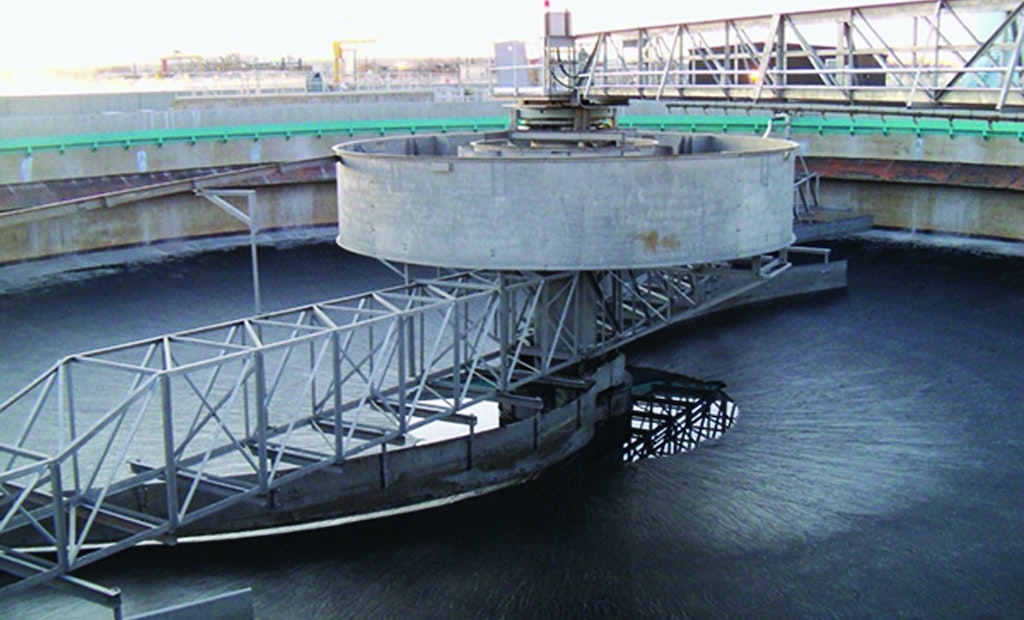Municipality updates clarifier system
Problem: A wastewater treatment plant in Albuquerque, New Mexico faced significant clogging in 12 clarifiers with narrow uptake pipes. The site needed to improve the flow to meet hydraulic requirements and reduce maintenance.
Solution: Envirodyne Systems designed the upgrade to convert the outdated equipment to 21st Century Spiral Blade Clarifier mechanisms. The collection systems fit the existing footprints and allow for minimal maintenance while enabling the clarifiers to maintain optimal capacity.
Result: The clarifiers provide a higher solids concentration, resulting in lower dewatering costs and maximum performance. 717-763-0500; www.envirodynesystems.com

Downtime avoided for biogas engine with self-resetting explosion relief valve
Problem: An Eastern U.S. wastewater treatment plant using biogas to fuel engines had frequent backfires and explosions in the exhaust duct system. Backfires occur when mapping air/fuel settings to achieve the optimum performance, since biogas has variable quality and a lower methane content. Explosion vent panels were installed on the exhaust ductwork to mitigate the effects of explosions. The frequency of backfires and the requirement to shut down the engine and replace the vents after each explosion led to extended downtime.
Solution: IEP Technologies supplied EVM Explosion Relief Valves. The company worked with plant maintenance personnel to calculate the size and quantity of explosion-relief valves needed to replace the vent panels. The self-resetting, closeable, spring-loaded relief valve has an integral flame arrester. It can be used indoors or outdoors and can be activated multiple times without plant downtime or maintenance. The valves are certified by ATEX and IACS. Each unit is tested for function, opening pressure and leak-tightness before shipment.
Result: The installation allowed plant personnel to optimize engine mapping settings and avoid downtime. Backfires and explosions in the exhaust duct were relieved without requiring immediate shutdown of the engine. 413-896-1485; www.ieptechnologies.com

Rotary press resolves challenges for city
Problem: The City of Becker, Minnesota, needed to upgrade its dewatering equipment to increase treatment capacity. A limited budget prevented building expansion or conveyor replacements. High humidity in the dewatering building was exerting pressure on the electrical equipment.
Solution: The city chose the Fournier Rotary Press, known for its small footprint and flexible output configurations. The presses were pre-assembled and skid-mounted at the factory, enabling installation without rebuilding the existing concrete floor. New conveyors that receive cake from the presses seamlessly integrated with the existing conveyor system.
Result: “Our staff has been extremely pleased with the high quality of the biosolids, the ease of operation, and the quietness of the equipment,” says Dave Pesola, water and wastewater department supervisor. “The significant reduction in water usage has been an added benefit. We have decreased moisture levels in the press room that had contributed to issues with the electrical and HVAC equipment.” 418-423-4241; www.fournierdewatering.com

Cake storage bin bridges the gap at water reclamation facility
Problem: The Waupun, Wisconsin, Wastewater Treatment Plant could not meet new phosphorus permit limits. The city hired a consulting engineer to evaluate options to bring the plant into compliance.
Solution: An advanced biological nutrient recovery process was constructed to remove nutrients through algae growth. The harvested algae are further processed by a dryer to produce granulate for beneficial reuse. Central to the process is a sliding frame storage system supplied by Schwing Bioset to bridge the process gap between algae and dryer operations. The custom-designed bin for storing dewatered algae includes vertical sidewalls to avoid bridging of sticky materials while maximizing storage volume. The sliding frame sends residual algae to a pump that feeds the dryer.
Result: With the intermediate storage system, the plant can operate its algae process continuously and operate the dryer on a schedule that supports the rate of algae production. The low-maintenance sliding frame provides the buffering storage needed in a compact process that is fully integrated into the plant SCADA system and doesn’t require additional operators or maintenance staff. 715-247-3433; www.schwingbioset.com






